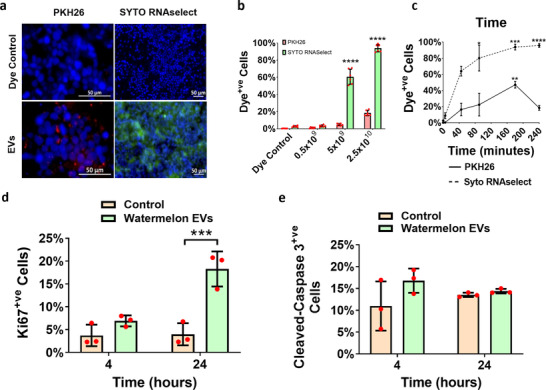Figure 2.

Watermelon extracellular vesicles and their RNA cargo are internalized into human intestinal epithelial cells and functionally active. a) Watermelon extracellular vesicles (WMEVs) were fluorescently labeled with the lipophilic dye PKH26 (WMEVPKH26; membrane labeling; Red) or the RNA‐binding dye SYTO RNAselect (WMEVRNAselect; RNA cargo labeling; green) and dye control or 2.5 × 1010 mL−1 labeled EVs were applied to differentiated Caco‐2 cells for 4 h. Concentration b) and time c) dependency of WMEV uptake was assessed by flow cytometry of trypsinized Caco‐2 cells treated with 5 × 108–2.5 × 1010 mL−1 EVs for 4 h or 2.5 × 1010 mL−1 EVs for 5–240 min respectively. Data are expressed as percentage of PKH26+ve or RNASelect+ve cells and presented as median ± interquartile range. n = 5–6, Kruskal–Wallis test with Dunn's multiple comparisons test (comparison to 0 min), * = p < 0.05, **** = p < 0.0001. The impact of WMEVs on Caco‐2 cell proliferation d) and apoptosis e) was assessed by immunocytochemical analysis of differentiated Caco‐2 cells incubated apically with 2.5 × 1010 mL−1 unlabeled WMEVs for 240 min then fixed or switched to fresh medium and cultured for a further 20 h prior to fixation, using primary antibody against Ki67or cleaved caspase, respectively.
